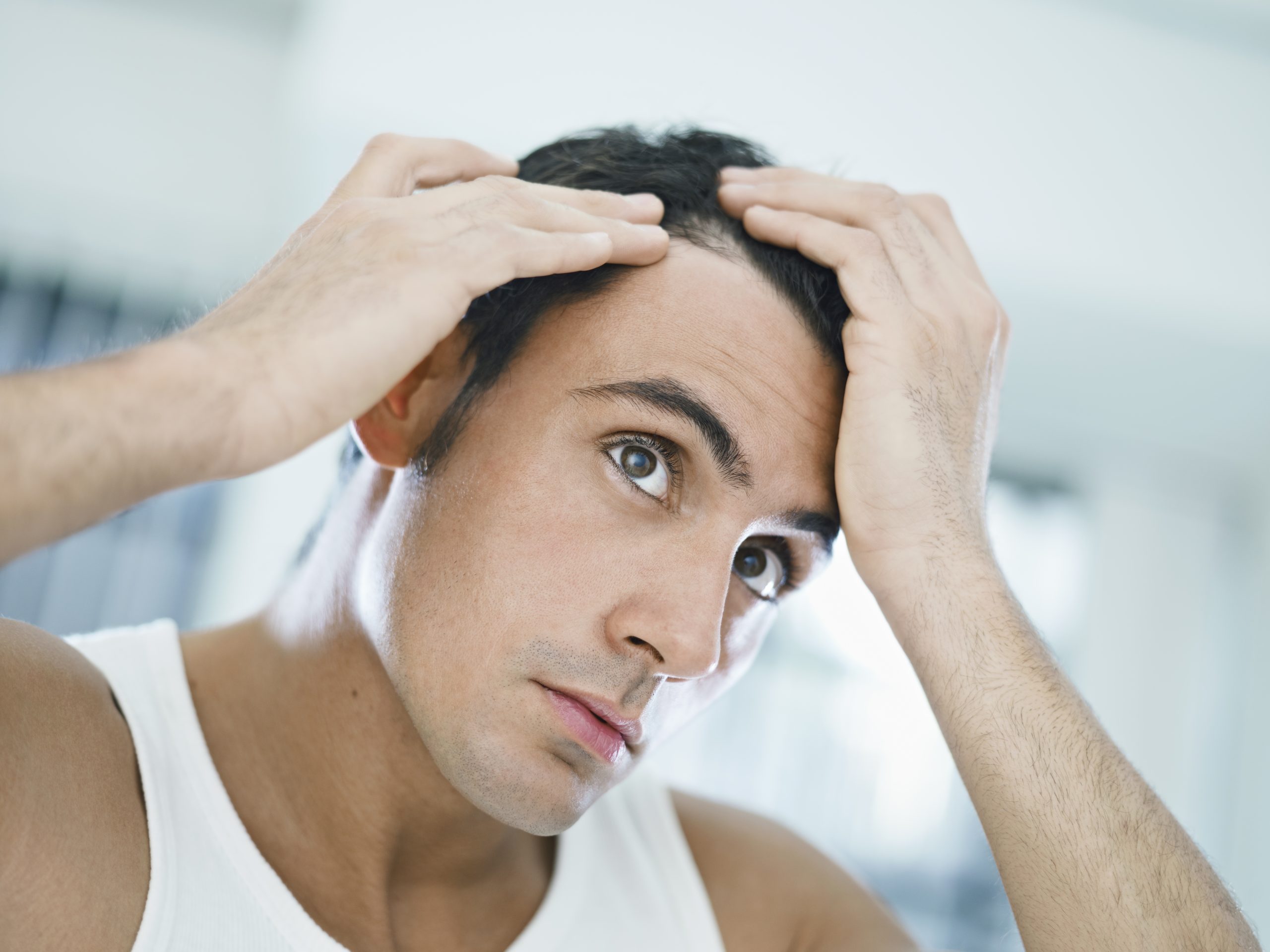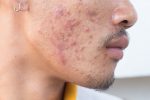Are you worried and upset about your hair loss or thinning hair? It is normal to lose hair. We lose 50-100 hairs a day without even noticing. Are you losing more than 100 hairs a day? Don’t worry, there are treatments that may help you with your hair loss.
Some types of hair loss are permanent, like male pattern baldness. This type of hair loss is genetic and usually runs in the family.
The other types of hair loss may be temporary. They may be caused by:
- Stress
- Weight loss
- Iron deficiency
- major illness or surgery
- side effects of medicines
- diseases like diabetes, thyroid imbalance, and some infections
Let us understand Male pattern baldness
Male pattern baldness is also known as Androgenetic alopecia. Hair loss follows a typical M-shaped pattern. It usually shows itself with advanced age.
The hairline starts thinning and often involves the crown at the top of the head. Male pattern baldness may or may not progress to complete baldness.
The male hormones are Androgens (testosterone). They are responsible for normal sexual growth and hair development in men. When these hormones go out of balance, the hair becomes thin and start falling off.
When does the hair loss start? What causes male pattern baldness? Is male pattern baldness reversible? Is it curable? What are the best products for treating hair loss? Is there a permanent solution for male pattern baldness? Read on.
At what age does male pattern baldness start?
The usual age group for this condition is about 50 years in men. Almost 50% of men show noticeable signs of hair loss by this age. Four out of every five men exhibit MPB by the age of 70.
The cases of bald headedness are not limited to old age. Unhealthy eating habits have disturbed the hormones of the younger generation.
The National Health Survey states 25% of men suffering from baldness experienced signs and symptoms at 20-21 years.
What are the different treatments and solutions for Hair loss?
Who does not want healthy hair? Hair loss could be it for any reason. It carries many social disadvantages. Lot of men with hair loss suffers from psychological stress and depression.
Hair loss treatment in 2020 uses modern methods and traditional ways. Some of the best products for hair loss or MPB are effective and cheap. Do you want to know the best treatments for hair loss? Continue to read.
Contemporary therapy
Modern medicine has many treatment options. They include oral medicine, topical solutions, Hair oils surgical and laser therapy. It would be best if you always took the treatment that fits your case.
No treatment is 100% effective. The best hair loss treatment involves balancing the hormone levels or getting a Hair transplant done. Hair transplant is an increasingly common treatment for MPB.
There are two popular medicines for MPB.
- Minoxidil 2% and 5%
- Finasteride 1mg tablets
Minoxidil comes in lotion or foam. 2% solution is for both men and women. The best medicine for male pattern baldness is a 5% solution.
Is male pattern baldness reversible with Minoxidil and Finasteride? Yes, but only if you use them daily. Once you stop using them you will start losing hair again.
Besides topical Minoxidil, some other creams also help hair grow. They contain biotin and melatonin. The results are incredibly positive with melatonin products.
Injectable solutions
If you are losing hair after surgery, then there some injections that can help. Scalp receives an injection of Platelet-rich plasma (PRP). It contains many growth-factors. The procedure finishes in a short time and requires no hospital admission.
Steroid injections also help thinning hairlines.
Micro needling is another invasive therapy found useful in MPB.
Hair transplant
Hair transplant is the most popular and successful treatment for baldness. How much does a hair transplant cost? It depends on the type of hair transplant and the amount of hairs needed. It could cost Rs 30,000 to Rs 90000 for 500 to 2000 hair grafts.
There are two types of hair transplant.
Follicular unit transplantation (FUT, or strip method):
A thin strip of skin with hair is removed from the back of your head and divided into pieces and placed in the scalp.
The site where the hairs are taken is closed with stiches. You will have a scar at the back of your head, but it can be covered with hair.
Follicular unit extraction (FUE):
Individual hairs are removed 1 by 1 from the back of your head and placed in the scalp.
Hair transplant usually takes a day. If a large area is being treated, you may need to have 2 or more sittings.
Laser
Research about lasers is still going on. A 2016 study indicated low-level laser therapy (LLLT) treats male pattern baldness effectively. It is a safe and painless procedure. If you cannot take medicine or put lotions on your scalp, then a laser is a good option.
Herbs and Natural remedies for Hair loss
There is treatment available for hair loss in Ayurveda and Homeopathy and there are hundreds of traditional cures and herbal products for men hair care and treat hair loss but there is no evidence that these methods can treat male pattern baldness.
Best oils for hair fall
Massage the scalp with any of these oils to increase the blood circulation to the scalp and reduce hair fall. These Hair oils will help the hair grow fast. These are some best oils for hair loss and hair regrowth.
- Coconut
- Olive oil
- castor oil
- peppermint
- rosemary
There are hair fall shampoos and hair growth serums available in the market to treat dry scalp and hair fall, but do they really work? Look up the ingredients and then shop for the best shampoo and conditioner for thinning hair.
Aromatherapy is a 100-year old traditional therapy for improving scalp health. The hair growth oils used in aromatherapy are sandalwood, lavender, rosemary, and thyme.
Best herbal supplements for Hair loss
Traditional remedies use old herbal ingredients and mixtures. They have proven effective in improving weak hair and scalp health. Scientific research supports many for their effectiveness.
Here are some of the star herbal ingredients. You may find them in some of the best hair loss products like the best shampoo for hair loss.
Saw palmetto, Onion juice, Fish oil, Ginseng, Green tea extract, Lemon oil and juice, Caffeine, Capsaicin, Curcumin, Garlic gel, and Apple cider vinegar.
Ayurveda uses Bhringraj, Hisbiscus, and Ashwagandha supplements. They are good for their hair health-promoting effects.
Aloe vera is available as an oral supplement. It is also found in many shampoos and conditioners.
Supplements containing Pumpkin seed oil and Saw palmetto are plant-based remedies. They balance the testosterone levels in the hair follicles, thereby promoting hair growth.
Hair loss vitamins and foods
Best vitamins and minerals for treating hair loss are Biotin, Niacin (Vitamin B3), Vitamin C, Zinc, and Iron. These vitamins help to grow healthy and longer hair.
Promote natural hair growth by eating a good hair loss diet. Here are top hair growth foods. Nuts, sweet potatoes, eggs, and spinach. If you are not eating enough of these foods try a hair loss supplement.
Take home message
Being a cultural taboo, hair loss may give rise to low self-esteem and psychological issues in men. But there are many treatment options available for male pattern baldness. There is always one right for you.
Always consult with your dermatologist before taking treatment because hair loss does not always need treatment. Make sure to get your levels checked before starting any supplements like zinc or iron.
Always purchase herbal supplements from reputed sources. Because an ‘herbal product’ label does not mean they are safe.













